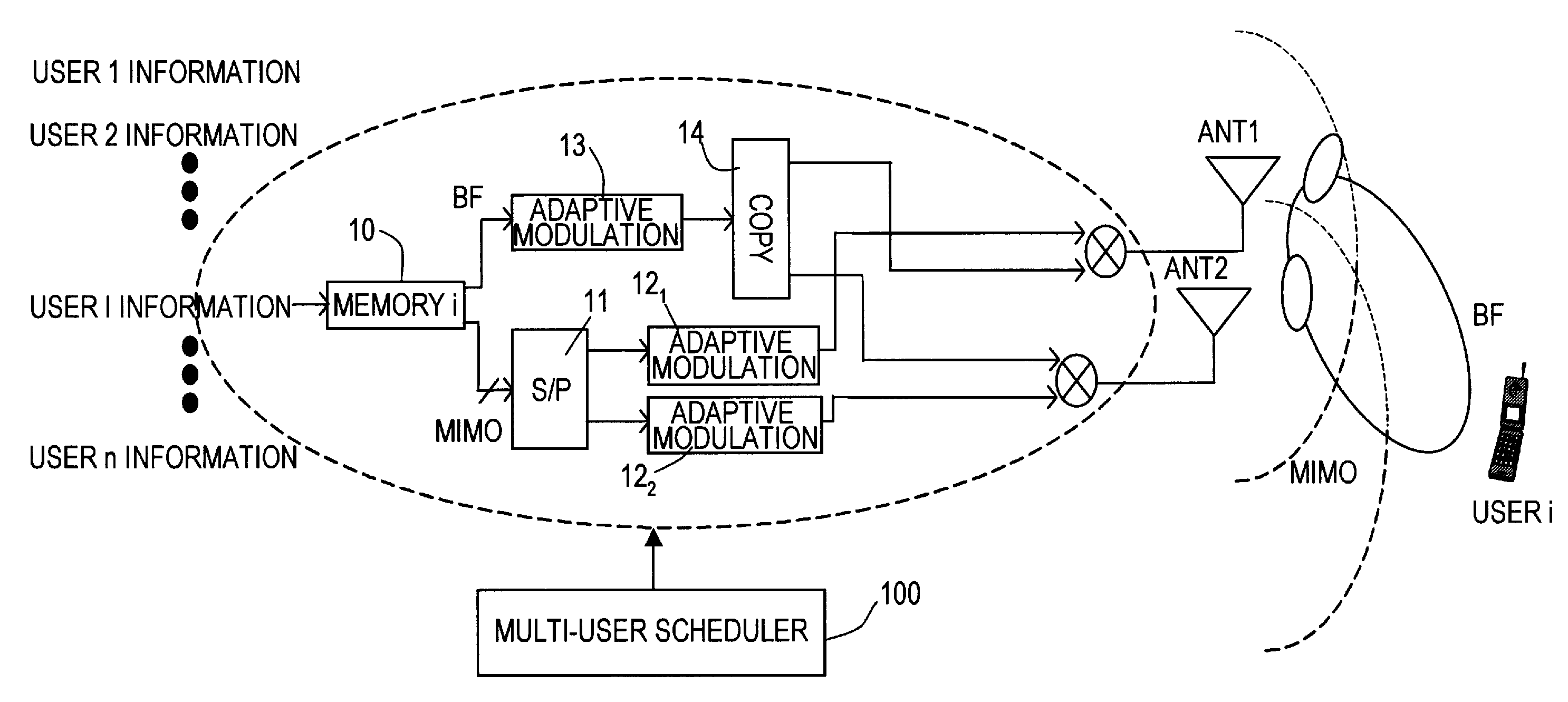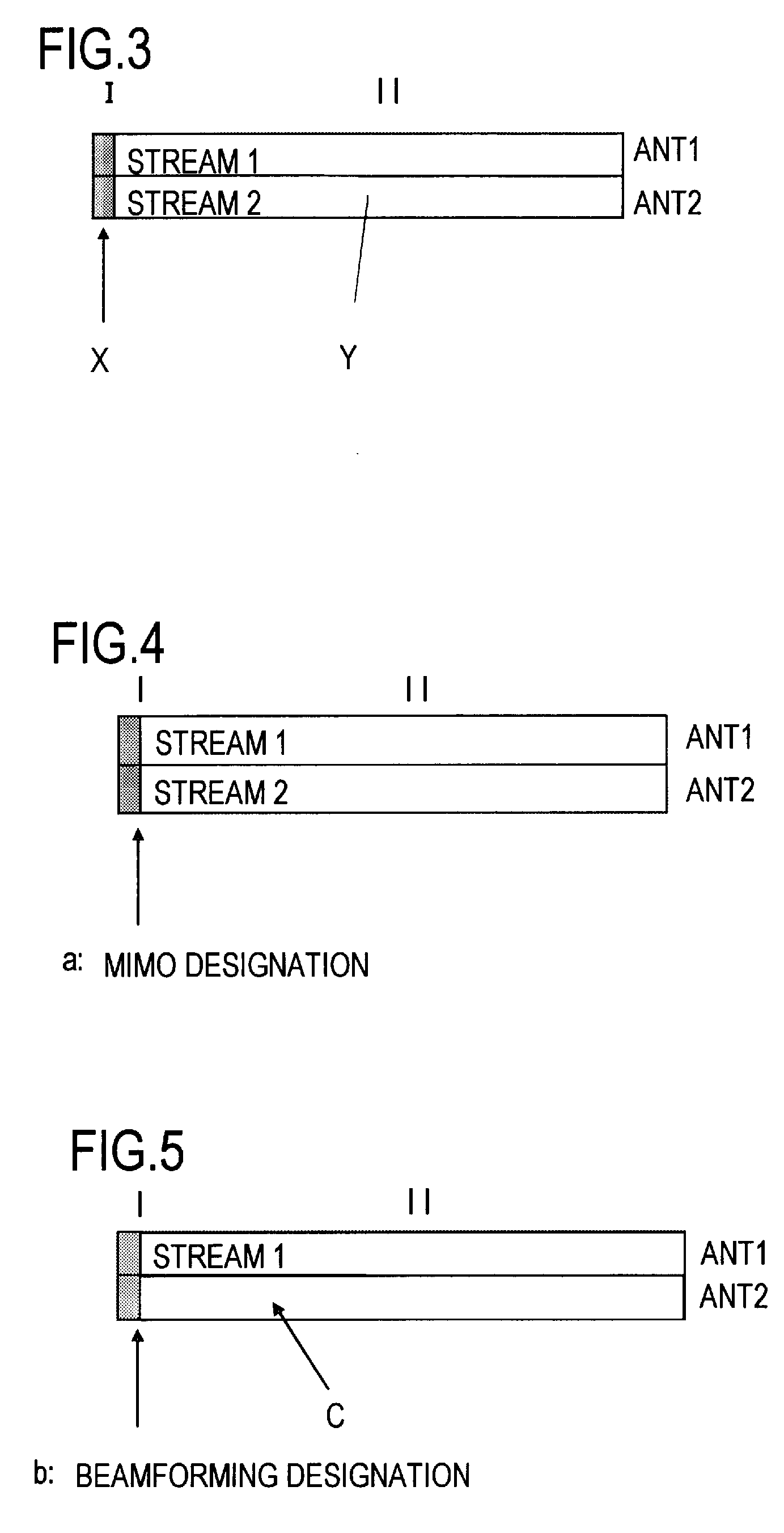Radio Communication System Using Multi-Antenna Transmission Technique, and Multi-User Scheduler Therefor
a radio communication system and multi-antenna transmission technology, applied in multiplex communication, signalling characterisation, wireless commuication services, etc., can solve the problem of difficult to simultaneously control both methods using a single common pilo
- Summary
- Abstract
- Description
- Claims
- Application Information
AI Technical Summary
Benefits of technology
Problems solved by technology
Method used
Image
Examples
embodiment 1
[0123]As an embodiment 1, the description is made in regard to a transmitting station in the implementation example listed as a group 1 of Table 1 as shown in FIG. 10, and in regard to a receiving station as shown in FIG. 11.
[0124][Transmitting Station]
[0125]In a transmitting station communicating with a plurality (n) of users, the data of the above plurality (n) of users are stored in advance in (n) memories 101-10n.
[0126]There is a mechanism of reading out data from memories 101-10n according to a request from a scheduler 100. Here, from the receiving station (refer to FIG. 11) of each user, feedback information is returned so as to report space propagation path information and the validity / invalidity of the transmitted data.
[0127]Scheduler 100 is operated by totaling the above information for the entire users. In FIG. 10, only a feedback information reception section 110 for one user is shown.
[0128]For example, an example of time multiplexing of each channel is shown in FIG. 10 a...
embodiment 2
[0187]Next, an embodiment 2 corresponding to the group 2 in Tables 1, 2 is described. FIGS. 15 and 16 show exemplary configurations of a transmitting station and a receiving station, respectively, corresponding to the embodiment 2.
[0188][Transmitting Station]
[0189]In FIG. 15, description is made with attention directed to the points of difference from the transmitting station according to the embodiment 1 shown in FIG. 10. The feature of the transmitting station corresponding to the embodiment 2 shown in FIG. 15 lies in that only information is reflected in scheduler 100 when the ZF solution is obtained from the channel matrix H fed back from the receiving station.
[0190]Also, because of a configuration reporting only the transmission weight wtx, it is different from the embodiment 1 in that a weight reported from scheduler management information generation section 102 is performed using Wtx.
[0191][Receiving Station]
[0192]Corresponding to the above modification in the transmitting st...
embodiment 3
[0195]An embodiment 3 corresponding to the group 3 shown in Tables 1, 2 is described. FIGS. 17 and 18 show exemplary configurations of a transmitting station and a receiving station, respectively, corresponding to the embodiment 3.
[0196][Transmitting Station]
[0197]As compared to the embodiment 2, in the embodiment 3, there is a difference only in the point that the information to be fed back is not the channel matrix H but a transmission weight (Wtx) 115d. As an improved point, the information amount to be fed back can be reduced. Also, as an advantageous point, it is also possible to point out that the calculation amount in the transmitting station can be reduced.
[0198][Receiving Station]
[0199]In the receiving station, as contrasted with the receiving station configuration of the embodiment 2 shown in FIG. 16, there is a difference in that, in regard to the information to be fed back, a ZF solution 231 obtained from the channel matrix H 221 by use of expressions (7), (8) is calcula...
PUM
 Login to View More
Login to View More Abstract
Description
Claims
Application Information
 Login to View More
Login to View More - R&D
- Intellectual Property
- Life Sciences
- Materials
- Tech Scout
- Unparalleled Data Quality
- Higher Quality Content
- 60% Fewer Hallucinations
Browse by: Latest US Patents, China's latest patents, Technical Efficacy Thesaurus, Application Domain, Technology Topic, Popular Technical Reports.
© 2025 PatSnap. All rights reserved.Legal|Privacy policy|Modern Slavery Act Transparency Statement|Sitemap|About US| Contact US: help@patsnap.com



